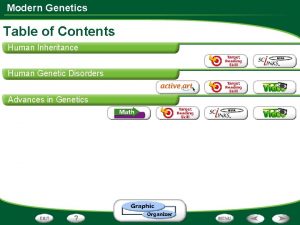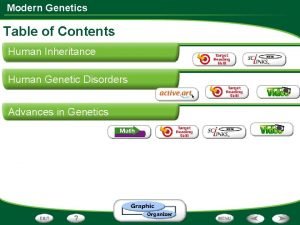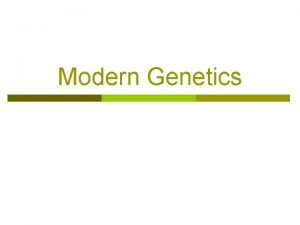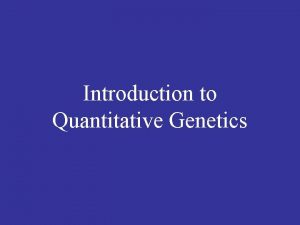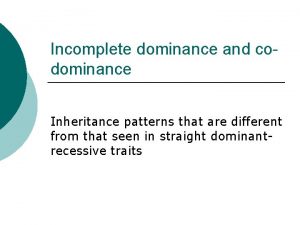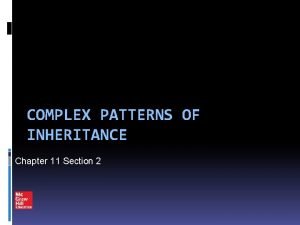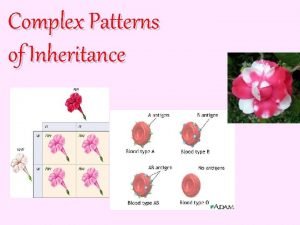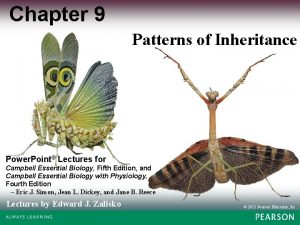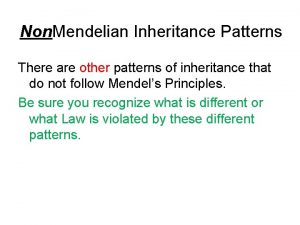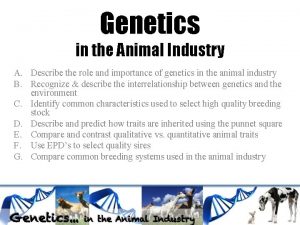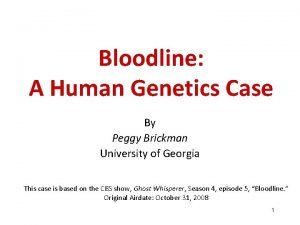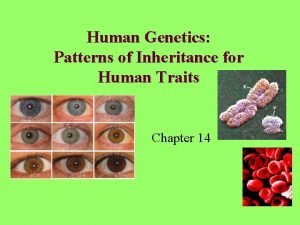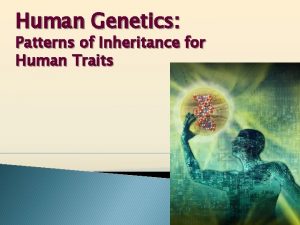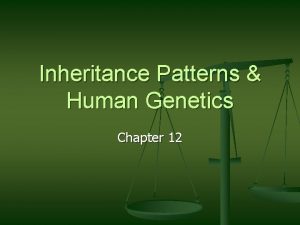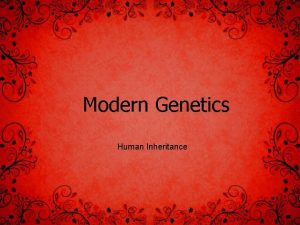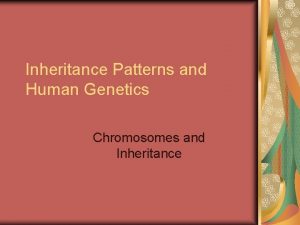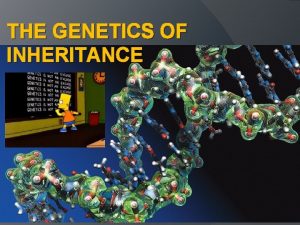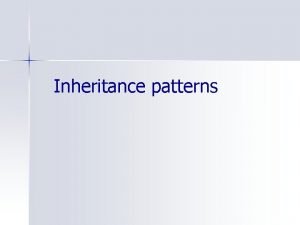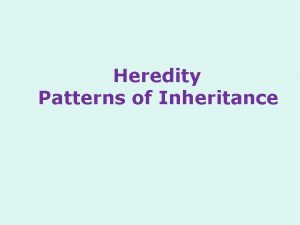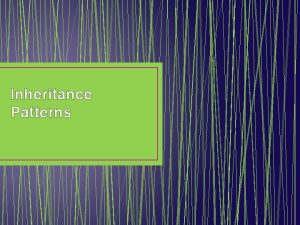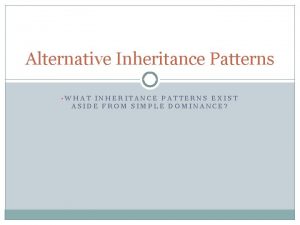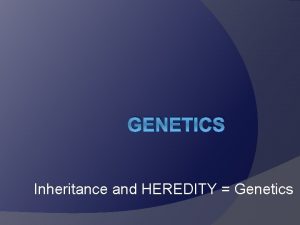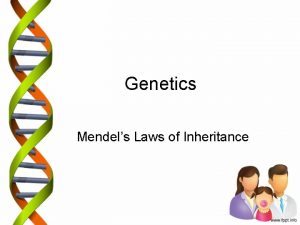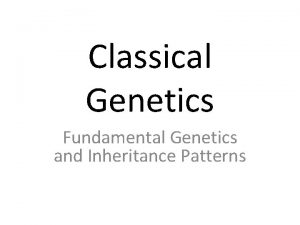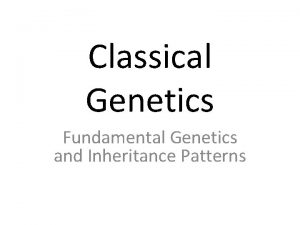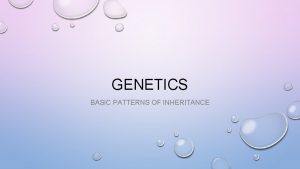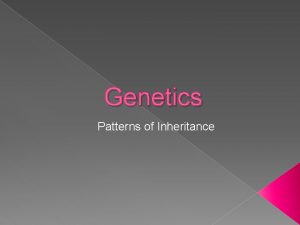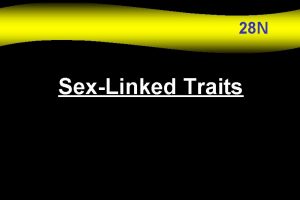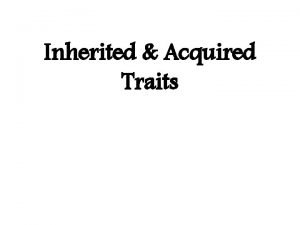Human Genetics Patterns of Inheritance for Human Traits
























- Slides: 24

Human Genetics: Patterns of Inheritance for Human Traits Chapter 14 sec. 14. 1 p. 341 -348

We will be discussing 5 Patterns of Inheritance for Human Traits 1. Single Allele Dominant 2. Single Allele Recessive 3. Sex Linked (X-Linked) 4. Multiple Alleles 5. Polygenic Traits

Single Allele Genes Regular traits that are either determined by a dominant or recessive allele on an autosome 1. Autosomal Dominant examples: a. Huntington’s Disease b. Achondroplasia (dwarfisim) c. Polydactyly (extra fingers and toes) 2. Autosomal Recessive examples: a. Albinism b. Cystic Fibrosis c. Sickle Cell Anemia

1. Dominant Allele Disorders Huntington’s Disease (HD) § Results in loss of muscle control and mental deterioration § No signs are shown until 30’s § Brain degeneration § Treatment: No cure, but drug treatments are available to help manage symptoms.

1. Dominant Allele Disorders Achondroplasia § Dwarfism § Person grows no taller than 4’ 4

1. Dominant Allele Disorders Polydactyly § The presence of more than the normal number of fingers or toes. § Can usually be corrected by surgery.

2. Recessive Allele Disorders Albinism § Lack of pigment in skin, hair, and eyes § Mutation in one of several genes which provide the instructions for producing one of several proteins in charge of making melanin.

2. Recessive Allele Disorders Cystic Fibrosis (CF) § Caused by recessive allele on chromosome 7 § Small genetic change (removes one Amino Acid) changes protein § Results in: Excess mucus in the lungs, liver and digestive tract, gets infection easily, and early death unless treated.

2. Recessive Allele Disorders Sickle Cell Disease § Red blood cells are bent and twisted § Get stuck in capillaries damage tissues § Results in weakness, damage to brain and heart

3. Sex Link Traits: Genes on the X and Y chromosomes Chapter 14 section 14. 2 p 349 -353

Lets recall how we determine gender… How do we determine the sex of an individual? through sex chromosomes § Sex Chromosomes: X and Y Female: XX Male: XY § Who is responsible for gender determination in the child? The father because he gives an X or Y to the gametes. The mother only gives an X to the gamete § Which sex chromosome is bigger? the X chromosome (y is much smaller)

What are sex-linked genes? genes found on a sex chromosome • X-linked genes are genes found on the X chromosome, symbolized by Xr, XR, Y 0. • Y-linked genes are found on the Y chromosome, symbolized by X 0, Y R, Y r • Thomas Morgan experimented with the eye color of fruit flies (Drosophilia) to determine Xlinkage

X-linked Genes • X-linked recessive traits will show up more often in males because they have only 1 X chromosome • Let’s do a punnett square for a female carrier of an x-linked gene and a recessive male • What will the genotypes be? • XRXr and XRY

Here’s the results • For girls: 0% have the trait • For boys 50% have it. • Probability is higher for boys because whatever X they get determines the trait, for girls they have to get 2 recessive X’s. R X r X XR XR Xr Y 0 XR Y 0 Xr Y 0

Examples of X-linked traits: 1. Color Blindness 2. Hemophilia 3. Muscular Dystrophy 4. Icthyosis simplex (scaly skin)

Colorblindness • A person with normal color vision sees a number seven in the circle above. • Those who are color blind usually do not see any number at all.

Colorblindness • RED-GREEN COLORBLINDNESS: • People with red-green color blindness see either a three or nothing at all. • Those with normal color vision see an 8.

Hemophilia- Lacking in the ability to clot blood – There is a gene on the “X” chromosome that control blood clotting – People who have hemophilia are missing the protein to clot blood – They can bleed to death by minor cut.

Muscular Dystrophy - Results in weakening/l oss of muscles - Caused by defective version of gene that codes for muscle

Sex-influenced Traits • Sex-Influenced traits are those that are on autosomes, but occur because of the sex hormones in male and female bodies. • Examples: Facial hair Baldness

4. Multiple Alleles – any gene that has 3 or more alleles (not just 1 dominant and 1 recessive) Example: Blood type has 3 alleles: IA= Type A blood (dominant) IB= Type B blood (dominant) i = Type O blood (recessive)

Check out the possible genotypes and phenotypes of blood below: Genotypes Phenotypes IAIA or IAi Type A IBIB or IBi Type B I AI B Type AB ii Type O

Blood has both Multiple Alleles and is Co. Dominant • If you have IAIB as you genes, you have both Type A and Type B blood, also known as Type AB • If you have IAi, i is recessive to IA, so you have type A blood • Q. When would you have Type O blood? • A. When you have ii as your genotype.

5. Polygenic Traits – traits controlled by 2 or more genes that interact, forming the trait § Usually show a wide range of phenotypes § Ex: Skin color, eye color, foot size, height – Wide range of skin colors because there are more than 4 genes that control this trait. § These may also be influenced by the environment, for example height. If not given the proper nutrition as a child, they might not be as tall as their genes dictate.
 Human inheritance modern genetics answer key
Human inheritance modern genetics answer key Genetics graphic organizer
Genetics graphic organizer Modern genetics human inheritance answer key
Modern genetics human inheritance answer key Chapter 11 section 1 basic patterns of human inheritance
Chapter 11 section 1 basic patterns of human inheritance Chapter 11 section 1 basic patterns of human inheritance
Chapter 11 section 1 basic patterns of human inheritance Qualitative traits vs quantitative traits
Qualitative traits vs quantitative traits Inheritance of quantitative traits
Inheritance of quantitative traits Inheritance of quantitative traits
Inheritance of quantitative traits Complete dominance pattern of inheritance
Complete dominance pattern of inheritance Complex patterns of inheritance
Complex patterns of inheritance Complex patterns of inheritance
Complex patterns of inheritance Chapter 9 patterns of inheritance
Chapter 9 patterns of inheritance Mendelian pattern of inheritance
Mendelian pattern of inheritance Chapter 9 patterns of inheritance
Chapter 9 patterns of inheritance Qualitative traits vs quantitative traits
Qualitative traits vs quantitative traits Qualitative traits vs quantitative traits
Qualitative traits vs quantitative traits Chapter 11 complex inheritance and human heredity test
Chapter 11 complex inheritance and human heredity test Sociologists define a symbol as
Sociologists define a symbol as 14-3 human molecular genetics answer key
14-3 human molecular genetics answer key Human genetics concepts and applications 10th edition
Human genetics concepts and applications 10th edition Peggy brickman
Peggy brickman Dating serves several important functions that include:
Dating serves several important functions that include: Mining frequent patterns associations and correlations
Mining frequent patterns associations and correlations Fspos
Fspos Typiska novell drag
Typiska novell drag
